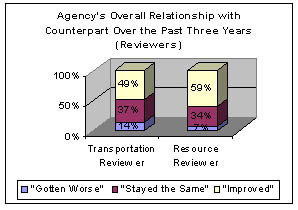















Successes in Stewardship: May 2004 |
|---|

|
Federal Highway Administration
May 2004
How Well Do We Work Together? Results from the Gallup Study

To gauge the effectiveness of interagency coordination in the NEPA process, FHWA commissioned a survey of personnel from resource and transportation agencies. FHWA will use the survey results as a baseline for improving interagency relationships.
As transportation agencies strive to implement the requirements of the National Environmental Policy Act (NEPA) in a timely manner, the Federal Highway Administration (FHWA) is continually improving its Environmental Streamlining initiatives. FHWA develops and provides tools to help all agencies involved in the NEPA process work together and streamline project delivery while ensuring environmental protection. This tool set, which includes programmatic agreements, negotiated timeframes, and memoranda of understanding, is designed to enable process efficiency with regard to both time and funding.
Common to many of these streamlining methods is the need for interagency coordination. When agencies have strong working relationships based on mutual respect and open communication, they are better able to effectively negotiate differences, make compromises, and reach agreements. However, when one party is hesitant to trust the other, the working relationship breaks down. Accordingly, the FHWA is looking for ways to improve communication between agencies.
FHWA recognizes that the first step toward improvement is understanding existing conditions. To help reach this understanding, FHWA commissioned The Gallup Organization to create a baseline survey of reviewers and managers at resource and transportation agencies. In response to Section 1309 of the Transportation Equity Act for the 21st Century, this survey is part of FHWA's effort to establish performance measures against which the progress of environmental streamlining initiatives may be assessed. The Gallup Survey captures the current state of relations between different agencies that are involved in transportation development and review, and creates a standard against which the quality of future interagency coordination may be compared.
The survey focused on assessing the attitudes and perceptions of different agencies, not on calculating the time needed to complete NEPA requirements. This qualitative approach is based on the belief that once the interagency processes are running smoothly, the improvements in delivery speed will naturally follow. The survey complements other components of FHWA's performance measurement of streamlining, such as the Berger Study, which focus on quantifiable results.
The Gallup Survey was nationwide, interviewing via telephone more than 700 officials from local, State, and Federal transportation agencies and more than 600 employees of State and Federal resource organizations. All survey respondents were managers or senior technical staff, and were directly involved in the NEPA documentation process. FHWA and Gallup identified these people as having enough experience with interagency coordination to make an informed judgment on the state of relationships between transportation and resource agencies.
Managers and the technical staff were asked questions concerning their overall relationship with counterpart organizations. For the purposes of this study, a counterpart organization for a transportation agency was defined as a specific resource agency with which the transportation agency worked, while the counterparts for resource agencies were the transportation agencies. Technical staff were asked additional questions regarding the performance of counterpart organizations on specific, recently completed transportation projects for which they have served as reviewers. The key intent was to identify which parts of the relationships were working smoothly and productively, and which parts needed improvement to achieve a streamlined process.
|
||||||||||||||||||||||||
|
||||||||||||||||||||||||
The survey questions focused mainly on timeliness and communication. The tables above contain data that typify most of the responses regarding specific projects. |
||||||||||||||||||||||||
The results of the Gallup Survey reveal that while the majority of participants and stakeholders in the Environmental Streamlining process are satisfied with most aspects of the overall relationships and project-focused interactions with their counterpart agencies, there remain many opportunities for improvement.
In general, interviewees from counterpart transportation agencies and resource agencies answered most of the questions about interagency relationships in very similar ways. For example, when asked to assess the performance of certain counterpart organizations on specifically cited NEPA projects, most of the respondents from transportation (67 percent) and resource (64 percent) agencies were either satisfied or very satisfied, while a small minority was dissatisfied or very dissatisfied by the performance (12 percent and 16 percent, respectively). This distribution was mirrored in subsequent questions regarding the quality of relationships, the quality of communication, and the timeliness of performance.
Next Steps: How your agency can
|
On occasion, however, opinions differed regarding a specific issue. Some interesting findings from the survey:
The complete results of the Gallup Survey can be viewed at http://environment.fhwa.dot.gov/strmlng/Gallup_overview.asp.
These and future survey results will enable FHWA to work with other agencies to assess which streamlining techniques are the most effective and where new streamlining techniques are needed. After initial improvements have been implemented and given a chance to work, a follow up survey will measure progress and identify further areas for improvement.
Kreig (Chip) Larson |
|
"Successes in Stewardship" is a Federal Highway Administration newsletter highlighting current environmental streamlining practices from around the country. To subscribe, call (617) 494-6352 or email esnewsletter@volpe.dot.gov. |
